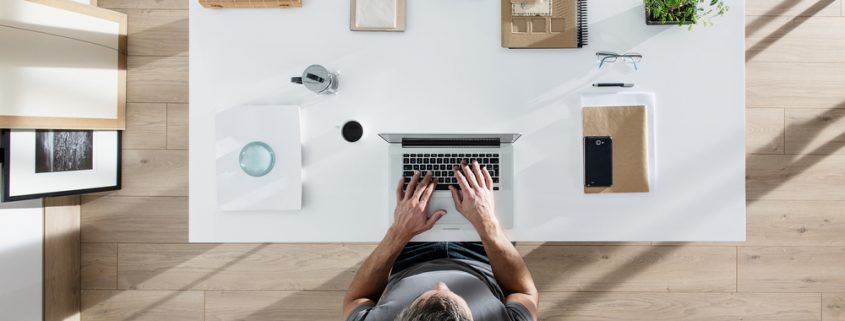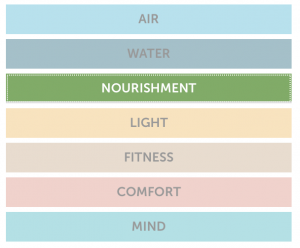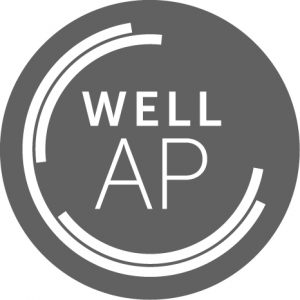The WELL Building Standard – Healthy Buildings, Healthy People
As we become more aware of the importance of building “green” we are also moving towards an area of design that goes beyond just building a better building, but designs which look to create an overall better occupant experience. Architects have been focusing on the aesthetics of the built environment since the dawn of design, but what if designs moved beyond just the visual and incorporated strategies to benefit peoples’ overall health, mood, diet, sleep, and fitness level?
On average people spend 90% of their life indoors. If we spend almost our entire lives inside buildings, shouldn’t those buildings improve our health and well-being rather than degrade it? The WELL Building Standardprovides a solid framework, backed by scientific research, that looks to create healthier and more people friendly buildings. Many studies have been conducted that look at the correlation between human health and comfort and productivity, turnover rate, employee retention and sick days.
Through the following concepts, The WELL Building Standard focuses on the main strategies needed to create a healthier and more productive design:
The system is made up of 100 performance metrics some of which are required (Preconditions) and some which are optional (Optimizations). WELL Certification is available for Core & Shell Projects, New & Existing Buildings, as well as New and Existing Interiors. WELL Pilots includes: Multi-family Residential, Educational Facilities, Retail, Restaurants, Commercial Kitchens, and others still in development. All projects must achieve all Preconditions to earn certification, scoring level is then determined on how many optimizations are met. Similar to LEED the level of achievements are ranked Silver, Gold and Platinum. The WELL Building Standard does have some overlapping elements from both LEEDv4 and The Living Building Challenge rating systems which focus on creating healthy and comfortable environment and culture that works with the body’s natural systems for improved living both inside and outside the workplace.
Below is the list of Preconditions and Optimizations in each of the seven concept categories:
(P)- Precondition (O) – Optimization
AIR:
01 Air Quality Standards (P)
02 Smoking Ban (P)
03 Ventilation Effectiveness (P)
04 VOC Reduction (P)
05 Air Filtration (P)
06 Microbe and Mold Control (P)
07 Construction Pollution Management (P)
08 Healthy Entrance (P) (O for Interiors)
09 Cleaning Protocol (P)
10 Pesticide Management (P) (NA for Interiors)
11 Fundamental Material Safety (P)
12 Moisture Management (P) (NA for Interiors)
13 Air Flush (O) (NA for Core & Shell)
14 Air Filtration Management (O)
15 Increased Ventilation (O)
16 Humidity Control (O) (NA for Core & Shell)
17 Direct Source Ventilation (O)
18 Air Quality Monitoring and Feedback (O)(NA for Core & Shell)
19 Operable Windows (O)
20 Outdoor Air Systems (O)
21 Displacement Ventilation (O)
22 Pest Control (O) (NA for Core & Shell)
23 Advanced Air Purification (O)
24 Combustion Minimization (O)
25 Toxic Material Reduction (O) (NA for Core & Shell)
26 Enhanced Material Safety (O) (NA for Core & Shell)
27 Antimicrobial Activity for Surfaces (O) (NA for Core & Shell)
28 Cleanable Equipment (O) (NA for Core & Shell)
29 Cleaning Equipment (O) (NA for Core & Shell)
WATER
30 Fundamental Water Quality (P)
31 Inorganic Contaminants (P)
32 Organic Contaminants (P)
33 Agricultural Contaminants (P)
34 Public Water Additives (P)
35 Periodic Water Quality Testing (O) (NA for Core & Shell)
36 Water Treatment (O)
37 Drinking Water Promotion (O)
NOURISHMENT
38 Fruits and Vegetables (P) (NA for Core & Shell)
39 Processed Foods (P)
40 Food Allergies (P)
41 Hand Washing (P) (NA for Core & Shell)
42 Food Contamination (P) (NA for Core & Shell)
43 Artificial Ingredients (P) (O for Core & Shell)
44 Nutritional Information (P) (O for Core & Shell)
45 Food Advertising (P) (O for Core & Shell)
46 Safe Food Preparation Materials (O) (NA for Core & Shell)
47 Serving Sizes (O) (NA for Core & Shell)
48 Special Diets (O) (NA for Core & Shell)
49 Responsible Food Production (O) (NA for Core & Shell)
50 Food Storage (O) (NA for Core & Shell)
51 Food Production (O)
52 Mindful Eating (O)
LIGHT
53 Visual Lighting Design (P) (NA for Core & Shell)
54 Circadian Lighting Design (P) (NA for Core & Shell)
55 Electric Light Glare Control (P)
56 Solar Glare Control (P) (O for Core & Shell)
57 Low-Glare Workstation Design (O) (NA for Core & Shell)
58 Color Quality (O) (NA for Core & Shell)
59 Surface Design (O) (NA for Core & Shell)
60 Automated Shading and Dimming Controls (O) (NA for Core & Shell)
61 Right To Light (O)
62 Daylight Modeling (O)
63 Daylight Fenestration (O)
FITNESS
64 Interior Fitness Circulation (P) (O for Interiors)
65 Activity Incentive Programs (P) (NA for Core & Shell)
66 Structured Fitness Opportunities (O) (NA for Core & Shell)
67 Exterior Active Design (O)
68 Physical Activity Spaces (O)
69 Active Transportation Support (O)
70 Fitness Equipment (O)
71 Active Furnishings (O) (NA for Core & Shell)
COMFORT
72 ADA Accessible Design Standards (P)
73 Ergonomics: Visual and Physical (P) (NA for Core & Shell)
74 Exterior Noise Intrusion (P) (O for Interiors)
75 Internally Generated Noise (P) (O for Core & Shell)
76 Thermal Comfort (P)
77 Olfactory Comfort (O) (NA for Core & Shell)
78 Reverberation Time (O) (NA for Core & Shell)
79 Sound Masking (O) (NA for Core & Shell)
80 Sound Reducing Surfaces (O)(NA for Core & Shell)
81 Sound Barriers (O) (NA for Core & Shell)
82 Individual Thermal Control (O) (NA for Core & Shell)
83 Radiant Thermal Comfort (O)
MIND
84 Health and Wellness Awareness (P)
85 Integrative Design (P)
86 Post Occupancy Surveys (P)(NA for Core & Shell)
87 Beauty and Design I (P)
88 Biophilia I – Qualitative (P) (O for Core & Shell)
89 Adaptable Spaces (O) (NA for Core & Shell)
90 Healthy Sleep Policy (O) (NA for Core & Shell)
91 Business Travel (O) (NA for Core & Shell)
92 Building Healthy Policy (O) (NA for Core & Shell)
93 Workplace Family Support (O) (NA for Core & Shell)
94 Self-Monitoring (O) (NA for Core & Shell)
95 Stress and Addiction Treatment (O) (NA for Core & Shell)
96 Altruism (O) (NA for Core & Shell)
97 Material Transparency (O)
98 Organizational Transparency (O) (NA for Core & Shell)
99 Beauty and Design II (O)
100 Biophilia II – Quantitative (O)
Part of the process in proving you met the required amount of Preconditions and Optimizations, requires that an on-site verification take place. Through “Spot Checks” and “Performance Tests” the project is validated for the site specific criteria addressed in the specific intent categories. The verification process is completed by a WELL Assessor, who is assigned by the GBCI and responsible for completing a full documentation review, as well as the on-site performance verification activities. In order to maintain WELL Certification, projects will need to re-certify every three years. Re-certification requires an on-site verification, along with updated letters of assurance, and changes to annotated documents. Businesses looking to pursue WELL or even just incorporate some of the concepts will benefit from conducting a pre and post study which looks at occupant turnover, health, sick days, overall comfort, etc. Performing this study will make for an excellent case study and also provide data indicating how the integrating healthy building concepts made direct improvements in the workforce and business. Integrating the WELL core concepts into the design and operation of a company’s culture, business managers will hopefully be able to see value added benefits through: improved employee moral, increased health of workforce, increased productivity and profit.
Ian Johnson – WELL AP





